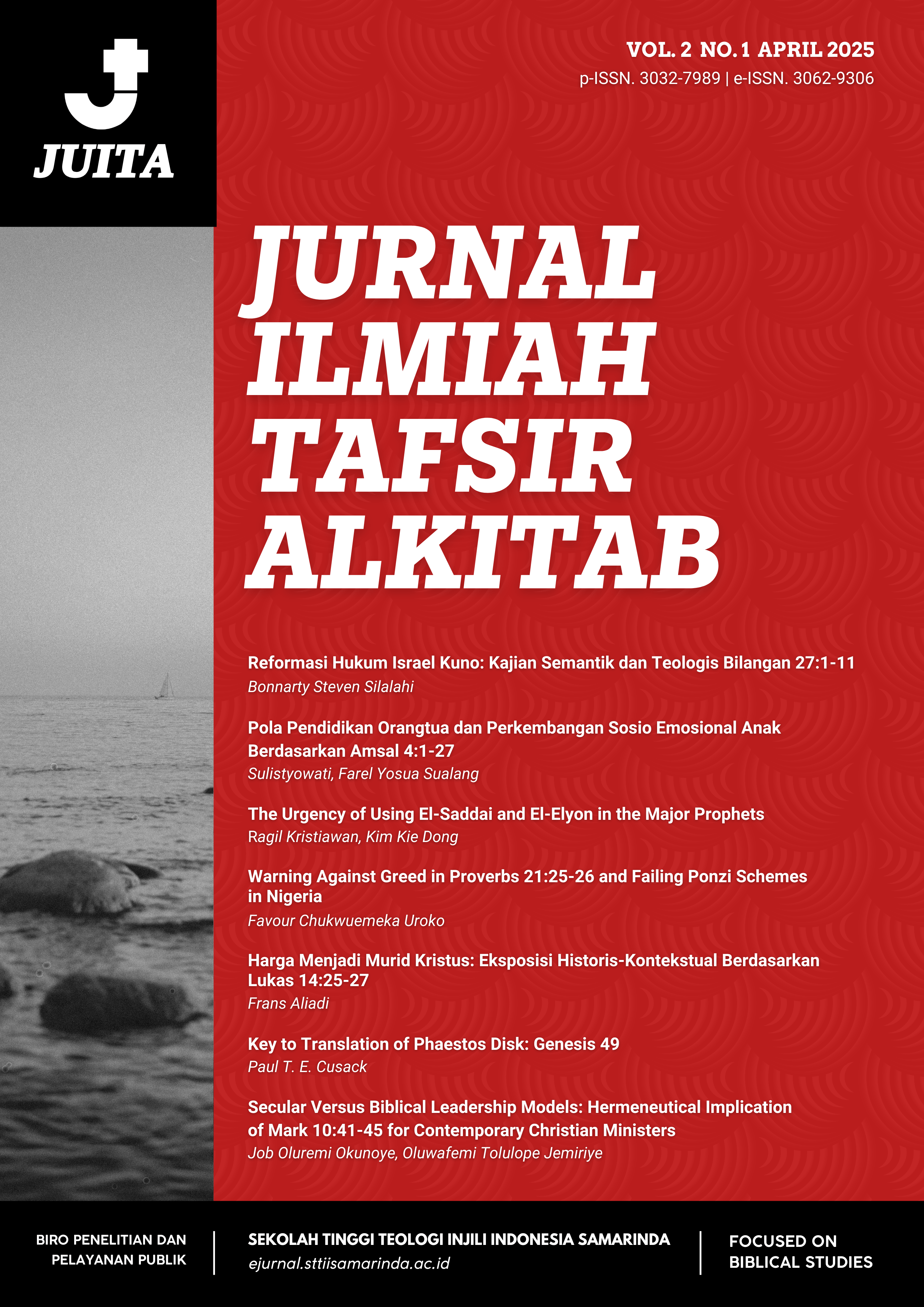The Urgency of Using El-Saddai and El-Elyon in the Major Prophets
DOI:
https://doi.org/10.69668/juita.v2i1.46Keywords:
El-Shaddai, El-Elyon, Major ProphetsAbstract
The Old Testament prophets had the primary task of returning the people to His Covenant. Throughout their ministry, these prophets often used the name Yahweh as God's covenant name to Israel. Interestingly, the books of the Major Prophets present the fact that the prophets also used the combined names of God El-Saddai and El-Elyon in their writings. What message is being conveyed in the use of these combined names of God? Using the study of Biblical Exegesis, it was concluded that the use of El-Shaddai taught Israel that God is still the greatest Person above all even though His human dwelling place, the Temple, has collapsed. The collapse of this building did not necessarily cause God to collapse as well. The use of El-Elyon in the major prophets provides important news that God is still the highest Person even though His people are being held captive in Babylon. The greatness of the Babylonian king is not comparable to the greatness of God who will later bring Israel out of Babylonian captivity. The use of these two combined names of God provides an important message for the people who are being held captive: God is still the great and high Person and is invincible by anything. For this reason, God's people must still place their trust only in God. The exile they experience is only temporary if they respond with faith. Belief in God must continue to grow when they experience oppression during exile.
Keywords: El-Shaddai, El-Elyon, The Major Prophets
Downloads
References
Baldwin, J. G. (2003). “Daniel,” in Tyndale Old Testament Commentaries (B. J. Nicholls (ed.)). Intervarsity Press.
Baxter, J. S. (2004). Menggali Isi Alkitab, Jilid 2: Ayub-Maleakhi (S. S. G.M.A Nainggolan, H. A. Oppusunggu (ed.)). Yayasan Bima Kasih / OMF.
Bentley, D. (1999). The 99 Beautiful Names of God for All People of the Book. William Carey Library.
Block, D. i. (1997). The Book of Ezekiel, Chapters 1-24. Wm. B. Eerdmans Publishing.
Bullock, C. hassel. (2014). Kitab-kitab Puisi dalam Perjanjian Lama. Gandum Mas.
Burns, J. b. (1973). The mythology of death in the Old Testament. Scottish Journal of Theology, 26(3), 327–340. https://doi.org/10.1017/s0036930600033585
Burrows, S. J. E. (1940). THE MEANING OF EL ŠADDAI. The Journal of Theological Studies, XLI(162), 152–161. https://doi.org/10.1093/jts/os-xli.162.152
Chinitz, J. (2007). The Prophets of Israel: both universalist and particularist. Jewish Bible Quarterly Dor Le Dor, 35(4), 249.
Costa, I. S. S. (2023). THE CONCEPT OF THE HEAVENLY SANCTUARY IN ISAIAH 14:12-15. PRÁXIS TEOLÓGICA, 18(2), 1701. https://doi.org/10.25194/2317-0573.2022v18n2.e1701
Gericke, J. (2012). Spectres of Yhwh : some hauntological remarks on Lamentations 3 : readings in Lamentations : essays on the text, interpretation and reception of Lamentations. Scriptura, 110(1), 166–175. https://journals.co.za/content/script/110/1/EJC131747
Green, D. (2001). Pembimbing pada Pengenalan Perjanjian Lama. Gandum Mas.
Greenberg, M. (1983). Ezekiel 17: A holistic interpretation. Journal of the American Oriental Society, 103(1), 149.
Irwin, N. (1984). Asia Bible Commentary Series: The Book of Daniel (B. J. Nicholls (ed.)). Asia Theological Association.
Koch, K. (2010). The Blackwell Companion to the Hebrew Bible (: Leo G. Perdue (ed.)). Blackwell Publishers.
Kotze, G. R. (2020). Human and divine persecution in the MT and LXX Lamentations 3:52–66. Routledge.
Kristiawan, R. (2016). Pengenalan Pada Perjanjian Lama. KAO Press.
Kristiawan, R. (2024). Pesan Teologis Penggunaan Nama Gabungan Allah י ד ַּ֔ ַׁ ַׁ ש ל ֵ֣ א ( El-Shaddai ) dalam Pentateukh. 1(2), 93–109.
Kwakkel, G. (2019). ON FINDING THE THEOLOGICAL MESSAGE OF OLD TESTAMENT BOOKS: a PLEA FOR PAYING ATTENTION TO THE REDEMPTIVE-HISTORICAL CONTEXT. UNIO CUM CHRISTO, 45–60.
Lee, S. (2016). Calvin and later reformed theologians on the image of God. UNIO CUM CHRISTO, 2(1), 127. https://doi.org/10.35285/ucc2.1.2016.art9
Miller, C. (2002). The Book of Lamentations in recent research. Currents in Biblical Research, 1(1), 9–29.
Nielsen, K. (2008). Ezekiel’s visionary call as prologue: from complexity and changeability to order and stability? Journal for the Study of the Old Testament, 33(1), 99–114. https://doi.org/10.1177/0309089208094462
Parker, B. J. (2014). A vision of hope and fear: Creative research and Ezekiel 1. Review & Expositor, 111(4), 390–400. https://doi.org/10.1177/0034637314552269
Poole, M. (1968). A Commentary on the Holly Bible 2: Psalm-Malachi. The Barner of Thruth Trust.
Poythress, V. S. (1976). The Holy ones of the most high in Daniel VII. Vetus Testamentum, 26(2), 208.
Resane, K. T. (2018). Biblical Exegesis and Hermeneutics of Biblical Texts: African Approaches. Pharos Journal of Theology, 99(1). https://doaj.org/article/84ac900e0e7b4aa6b5c39eef85cb677d
Roberts, R. R. (2013). Lamentations 3. Interpretation a Journal of Bible and Theology, 67(2), 196. https://doi.org/10.1177/0020964312472646
Schwebel, I. F. P. (2014). Lament in Jewish Thought: Philosophical, Theological, and Literary Perspectives. De Gruyter. https://doi.org/10.1515/9783110339963
Stevens, K. (2014). The Antiochus cylinder, Babylonian scholarship and Seleucid Imperial ideology. The Journal of Hellenic Studies, 134, 66–88. https://doi.org/10.1017/s0075426914000068
Susila, T. (2022). Sacrifice and Tribute in Hosea 6:6: The Implication of Contextual Worshipping. Interdisciplinary Social Studies, 1(5), 617–623. https://doi.org/10.55324/iss.v1i5.129
Thompson, T. L. (1999). The mythic past: biblical archaeology and the myth of Israel. Choice Reviews Online, 37(04), 2120. https://doi.org/10.5860/choice.37-2120
Towns, E. L. (2014). Nama-nama Allah. Yayasan ANDI.
Vida, G. L. Della. (1944). El ’Elyon in Genesis 14:18-20. Journal of Biblical Literature, 63(1), 1. https://doi.org/10.2307/3262503
Walvoord, J. F. (2003). Pedoman Lengkap Nubuat Alkitab: Penjelasan yang Gamblang untuk Waktu tang Tak Menentu (R. Sutedja (ed.)). Yayasan Kalam Hidup.
Weeks, S. (2009). Jeremiah as a Prophetic Book: From the book Prophecy in the Book of Jeremiah. De Gruyter. https://doi.org/10.1515/9783110212815.265
Wegner, P. (2020). Daniel: An introduction and commentary. Bulletin for Biblical Research, 30(1), 142.
Wyatt, N. (2009). The concept and purpose of Hell: its nature and development in West Semitic thought.
Numen, 56(3), 161–184. https://doi.org/10.1163/156852709x404964
Downloads
Published
How to Cite
Issue
Section
License
Copyright (c) 2025 Jurnal Ilmiah Tafsir Alkitab

This work is licensed under a Creative Commons Attribution 4.0 International License.
















